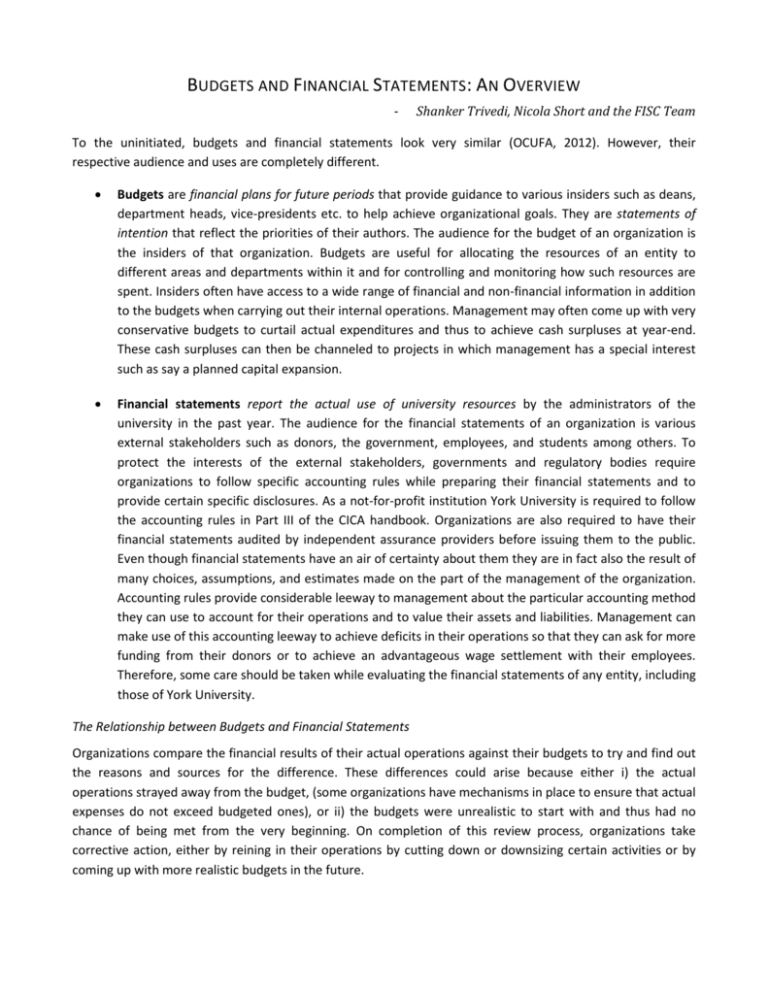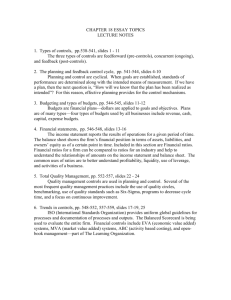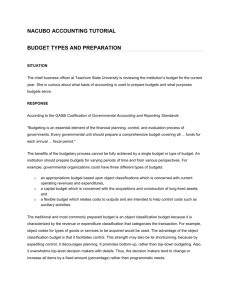Budgets and Financial Statements
advertisement

BUDGETS AND FINANCIAL STATEMENTS: AN OVERVIEW - Shanker Trivedi, Nicola Short and the FISC Team To the uninitiated, budgets and financial statements look very similar (OCUFA, 2012). However, their respective audience and uses are completely different. • Budgets are financial plans for future periods that provide guidance to various insiders such as deans, department heads, vice-presidents etc. to help achieve organizational goals. They are statements of intention that reflect the priorities of their authors. The audience for the budget of an organization is the insiders of that organization. Budgets are useful for allocating the resources of an entity to different areas and departments within it and for controlling and monitoring how such resources are spent. Insiders often have access to a wide range of financial and non-financial information in addition to the budgets when carrying out their internal operations. Management may often come up with very conservative budgets to curtail actual expenditures and thus to achieve cash surpluses at year-end. These cash surpluses can then be channeled to projects in which management has a special interest such as say a planned capital expansion. • Financial statements report the actual use of university resources by the administrators of the university in the past year. The audience for the financial statements of an organization is various external stakeholders such as donors, the government, employees, and students among others. To protect the interests of the external stakeholders, governments and regulatory bodies require organizations to follow specific accounting rules while preparing their financial statements and to provide certain specific disclosures. As a not-for-profit institution York University is required to follow the accounting rules in Part III of the CICA handbook. Organizations are also required to have their financial statements audited by independent assurance providers before issuing them to the public. Even though financial statements have an air of certainty about them they are in fact also the result of many choices, assumptions, and estimates made on the part of the management of the organization. Accounting rules provide considerable leeway to management about the particular accounting method they can use to account for their operations and to value their assets and liabilities. Management can make use of this accounting leeway to achieve deficits in their operations so that they can ask for more funding from their donors or to achieve an advantageous wage settlement with their employees. Therefore, some care should be taken while evaluating the financial statements of any entity, including those of York University. The Relationship between Budgets and Financial Statements Organizations compare the financial results of their actual operations against their budgets to try and find out the reasons and sources for the difference. These differences could arise because either i) the actual operations strayed away from the budget, (some organizations have mechanisms in place to ensure that actual expenses do not exceed budgeted ones), or ii) the budgets were unrealistic to start with and thus had no chance of being met from the very beginning. On completion of this review process, organizations take corrective action, either by reining in their operations by cutting down or downsizing certain activities or by coming up with more realistic budgets in the future. Financial Transparency An organization like YUFA often has to face the question of which source of financial information, the budget or the financial statements, it should use for understanding University finances. Ideally, YUFA should be able to use and depend on both the budget and the financial statements of York University. However, reality is not that clear-cut. The annual budgets of York University are opaque documents that start off from a base year such as 2004 or 2011 to which additions and subtractions are made to arrive at the budget of a particular year. It is not clear what the basis for these adjustments is. Further, the annual budgets are not broken down by line item so that they can be compared to the corresponding line items on the actual financial statements for that financial year. York University is presently in the process of transitioning to a different budgeting model. However, no actual budget under the new model is available as yet. Therefore, presently YUFA can only make high level comparisons between budgeted total revenues and total expenses and actual total revenues and total expenses. When we compare York University’s budgets and actual financial statements for the past years we find that there is a huge variation between the budgeted revenues and actual revenues, and likewise between budgeted expenses and actual expenses. Further, while York has projected operating deficits in most of its budgets for the past 10 years, the reality is actually different. Over the past 10 years York generated a cumulative operating surplus of $176 million. Given the undependability of York University’s budgeted numbers YUFA has to mainly depend on the annual financial statements of York University and other information either publicly available or provided by the employer in its decision making process. The YUFA-side of the Joint Financial Information Subcommittee has requested that budgets be reported in a manner more consistent with financial statements and we will keep members apprised of the outcome of that request. Financial Statements of Not-for-Profits The financial statements issued by not-for-profits bear some similarities to the financial statements issued by for-profit entities and often are called by the same name. Further, some of the accounting rules followed by not-for-profits are also similar or identical to those followed by for-profit entities. However, the goals and objectives of these two types of entities are not the same. Not-for-profit entities, as their name denotes, do not operate with the aim of making profits. However, this does not mean that not-for-profits aim to make losses: they do aim to achieve their goals and mission in the most effective and efficient manner and thus generally aim to break-even in their long term operations. This can mean that in the short-run, not-for-profits may generate surpluses on an annual basis that can be used to fund future operations including capital investments. Conversely, not-for-profits can also generate deficits in the short run with the understanding that those deficits will be covered by past surpluses or from surpluses expected in future periods. Further, not-forprofits, unlike for-profit entities, do not have owners who share in the residual interest of the entity. That is, the owners of for-profit entities share in any profits and accumulated profits left over in the entity after paying off other interested parties like creditors, debt-holders, and preference shareholders. In contrast, not-forprofit entities have a fiduciary obligation to their missions: in the case of York University, established by the York University Act of 1959, to that of research and teaching in the public interest. Further reading Bill Salatka, ‘The Differences between Budgets and Financial Statements: A primer on financial documents produced by universities’ (Toronto: OCUFA, November 2012)







